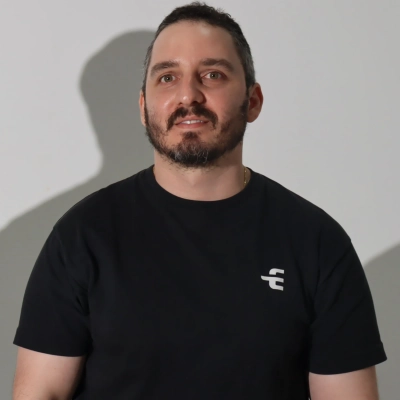25 Unconventional Ways to Reduce Small Business Overhead Costs
Small business owners constantly seek creative ways to reduce overhead costs, and this article presents 25 unconventional strategies backed by insights from industry experts. From implementing AI chatbots for customer service to adopting zero-waste models that generate both savings and innovation, these practical approaches have proven successful across various sectors. These cost-cutting methods challenge traditional business assumptions while delivering significant financial benefits without compromising operational quality or customer satisfaction.
AI Chatbot Reduces Customer Service Needs
One unconventional but highly effective way we've reduced overhead costs at Eprezto was by implementing AI to handle 70% of our customer interactions in chat.
Most customer questions are very repetitive, things like 'What's the price of this policy?' or 'Does it cover this type of car?'. These don't require a human to answer. By building an AI-powered chatbot to respond to these queries and even guide customers through our website, we eliminated the need to hire an extra customer support agent.
Today, we have just one customer service representative for over 20,000 customers. This approach has saved us six to ten hours of manual work every month for the team, reduced labor costs, and improved response times for customers.
The impact on operations has been huge: our team can focus on higher-value tasks instead of answering repetitive questions, and customers get faster, more consistent answers. It's a win-win that's improved efficiency and reduced overhead significantly.

Remote Work Saves Thousands Before COVID
We shifted to a completely remote setup three years before COVID, saving $36,000 annually in office rent. That money went directly into better software tools and employee benefits, which improved both productivity and retention. The key was implementing strong communication systems from day one—daily standups and project management tools prevented the isolation and confusion that sink remote teams.
Silent Quarter Reveals True Value of Expenses
One unconventional way I reduced overhead costs in my business was by running what I called a "silent quarter"—a three-month experiment where we intentionally paused or simplified every recurring expense that wasn't directly tied to revenue or client experience. Instead of cutting staff or chasing cheaper tools, the goal was to question why each cost existed in the first place.
We paused subscriptions, stopped all non-essential automation, and replaced some software with shared templates or manual workflows for a short period. It wasn't glamorous, but it forced the team to see which systems truly created leverage and which ones were just digital clutter. What surprised us was how much "convenience" was costing us. By the end of the quarter, we'd reduced SaaS and operational expenses by nearly 38%, without losing productivity or clients.
The biggest insight wasn't just the savings—it was clarity. Once we stripped things back, we saw where human creativity actually outperformed automation. That changed how we budgeted going forward. Every tool or expense had to earn its place with a measurable ROI or a clear time-saving benefit.
The long-term impact was cultural. The team became more resourceful and intentional. Meetings got shorter, workflows tightened, and people started suggesting smarter ways to operate because they understood the real cost of "ease." It was less about being frugal and more about being focused.
That "silent quarter" ended up being one of the most profitable periods we'd had—not because we worked harder, but because we stopped paying for things that didn't make us better.
Serverless Setup Cuts Infrastructure Costs Dramatically
Moving PlayAbly to a serverless setup changed everything. Our infrastructure costs dropped by about 70%, and launches stopped being all-night stress-fests. The engineering team could finally ship updates on their own schedule, and players noticed fewer connection drops. If your cloud bill keeps climbing, serverless is something you should seriously consider.
Route Optimization Boosts Cleaning Crew Efficiency
We switched our cleaning crews to route optimization software instead of doing it all by hand. We're saving about $2,000 a month on gas and each team can squeeze in two extra appointments daily. It took a minute to get used to, but now we're way better at handling last-minute requests. If you're juggling multiple crews, this is absolutely worth it.

Seasonal Menus Lower Food Costs
One unconventional way we've reduced overhead at Block & Rooster Provisions was by building menus around seasonal and locally available ingredients rather than relying on fixed dishes year-round. This flexibility allows us to buy what's freshest and most cost-effective directly from nearby farms and small distributors, often at a lower cost than wholesale chains.
The savings were significant—roughly 15-20% reduction in food costs—but the true impact went beyond finances. It improved our ingredient quality, strengthened relationships with local producers, and gave clients a more authentic farm-to-table experience. It turned cost-cutting into a creative advantage that elevated both our brand and the dining experience.

Refurbish Equipment Instead of Replacing It
One unconventional way we've reduced overhead costs was by reusing and refurbishing some of our shop equipment instead of immediately replacing it. In the auto repair industry, it's easy to assume newer is always better, but we found that restoring older spray guns, lifts, and prep stations with high-quality parts and maintenance actually gave us the same performance at a fraction of the cost.
We also started bulk-ordering paint and materials with nearby shops in our network. By pooling orders, we negotiated better pricing with suppliers and cut material costs by nearly 15%. That collaboration not only saved money but also built stronger relationships within the local auto body community.
The savings were significant enough that we were able to reinvest in staff training and marketing without increasing overall expenses. It proved that innovation in cost management doesn't always mean high-tech solutions and sometimes it's just about thinking resourcefully and making the most of what you already have.
Audit Underutilized Potential Through Tech Simplification
One of the most unconventional ways we reduced overhead costs at Zapiy came from a mindset shift rather than a traditional cost-cutting measure. Early on, like most startups, we were obsessed with scaling—bigger teams, bigger offices, more tools. But during one financial quarter when our burn rate was climbing faster than our revenue, I had to stop and ask myself: were all these "growth" expenses actually fueling growth?
Instead of trimming obvious costs, we ran an internal audit on *underutilized potential*. I encouraged every department head to identify one area where we were paying for "convenience" rather than value. What surprised me was how often that pointed to software tools. We were using five different platforms that basically did the same thing—project tracking, communication, reporting—and none of them were fully optimized.
So, we did something counterintuitive: we consolidated tech stacks and started building internal micro-tools using AI automations. It was a bit of a gamble—replacing high-cost SaaS subscriptions with leaner, custom-built workflows—but it worked better than expected. Within six months, we reduced our software spend by over 40%, but the real benefit wasn't just financial. The team suddenly had more clarity and fewer distractions. We'd simplified the ecosystem they worked in, which made them faster and more focused.
I've seen similar results with clients across industries—once they question whether every expense is serving the *mission* instead of the *moment*, savings naturally follow. It's not about cutting costs just to save money; it's about realigning every dollar with purpose.
That experience fundamentally changed how I view operational efficiency. Sometimes innovation isn't about adding more—it's about creating smarter simplicity. By doing less, but with sharper intent, we freed up resources to invest in what truly mattered: people, product quality, and long-term resilience.
Shared Kitchen Space Slashes Restaurant Overhead
Here's a move that really worked for me. I moved one of our restaurants into a shared kitchen with other chefs. A job at Prelude taught me the value of that collaboration, so we split the space and the gear. Our monthly costs dropped about 40%. We could test new menu ideas without the pressure of high rent, and the team adapted fine. Honestly, don't overlook shared spaces. They give you room to experiment and save you a lot of money.

Transform Unique Spaces Into Temporary Retail
I eliminated showroom rentals to create temporary retail spaces in non-traditional locations including abandoned dance studios and artist lofts and garden patios. The new approach reduced our monthly expenses by thousands while providing customers with authentic and personal shopping experiences. The shopping experience evolved into a journey through our authentic environment instead of traditional retail spaces.
The financial savings enabled me to purchase better design elements and fabrics while the new approach brought a sense of freedom to our work. Our business reached customers at their existing locations and life spaces instead of following traditional retail guidelines.
Zero-Waste Model Creates Savings and Innovation
We managed to lower costs by moving to a zero-waste production model, in which every part of the plant, from leaf to root, is either used in our formulations or composted back into the soil. This approach reduced waste disposal expenses and improved how we source our ingredients. The savings allowed us to reinvest in research and innovation. Our team also became more engaged and creative, turning what was once discarded into new product ideas.
What started as a sustainability initiative soon became a source of innovation. It showed that careful production helps the planet and creates efficiencies and opportunities. The more we respected our resources, the more they gave back. This approach encouraged us to explore new methods, develop fresh products and continue finding value in every part of what we use, strengthening both our business and our commitment to nature.

In-House Automation Replaces Outsourced Billing Services
One unconventional yet highly effective cost reduction strategy at Best DPC was switching from outsourced billing and administrative services to an in-house model supported by automation. Rather than cutting staff, we cross-trained team members to manage both patient coordination and billing tasks with the help of a lightweight AI-driven platform.
The shift reduced our overhead by nearly 30% within the first year while improving accuracy and turnaround times. More importantly, it kept patient data within the clinic, strengthening confidentiality and control. The impact extended beyond savings—it improved workflow efficiency and increased team ownership. Employees developed a deeper understanding of how daily operations affected financial health, creating a stronger connection between service quality and sustainability. The outcome was a leaner, more cohesive practice that operates with both precision and purpose.

Train Staff for In-House Fleet Maintenance
An unconventional way we reduced overhead costs was by switching part of our fleet maintenance to an in-house program. Instead of sending every vehicle to an outside shop for routine service, we trained one of our team members who already had mechanical experience to handle oil changes, tire rotations, and minor repairs on-site. It started as a trial to save time between appointments, but it ended up cutting thousands in annual maintenance costs.
The impact went beyond savings. By having maintenance done in-house, our trucks spent less time off the road, making scheduling smoother and service calls more efficient. It also gave that employee a new skill set and sense of ownership in the business. What surprised me most was the significant efficiency gain from such a simple change — it reminded me that sometimes the best cost-saving ideas come from within the team, not from cutting corners.

Mobile Notaries Replace Traditional Title Companies
I stopped using traditional title companies for every transaction and instead built relationships with a mobile notary network that handles closings at sellers' kitchen tables. This unconventional approach cut my closing costs from around $800-1,200 per deal down to $200-300, saving me over $18,000 last year across our transactions. The real game-changer wasn't just the money--sellers absolutely loved the convenience of closing at home in their pajamas if they wanted, which led to more referrals and smoother negotiations because we removed that intimidating conference room atmosphere.

Extended Hours Beat Expensive Office Expansion
We were about to sign a new lease for a bigger space. Then I had an idea. What if we just extended our weekday hours from 7:30am to 9pm? We tried it. All of a sudden, clients who couldn't make a 9-to-5 appointment started booking with us. Our cost per client dropped by over a third, and we didn't spend an extra dime on rent. Sometimes the best solution isn't more space, it's just better timing.
Free Resource Hub Cuts Administrative Costs
I tapped into my teaching roots to create a free online resource hub with video tutorials and downloadable guides for homeowners navigating difficult sales. This unconventional approach cut our customer service hours by about 40%, saving roughly $15,000 annually on administrative costs, while simultaneously building trust--sellers now come to us better prepared, which streamlines the entire transaction process.

Energy-Efficient Practices Lead to Monthly Savings
At ALP Heating LTD., we've always believed that innovation can come from unexpected places, and one unconventional approach we've taken to reduce overhead costs is through the implementation of energy-efficient practices not only in the services we provide but also in our own operations. As the CEO and founder, I've seen firsthand how adopting a sustainability mindset can yield significant savings while enhancing our operational efficiency.
For example, we invested in smart thermostats and energy-efficient lighting for our office and warehouse. Initially, this required an upfront cost, but over time, the reduction in energy consumption led to lower utility bills-savings that have equated to approximately 20% off our monthly expenses. This not only improved our bottom line but also set a precedent for our team to prioritize energy efficiency in the services we offer to clients. It's a win-win scenario where we can promote eco-friendly solutions to our customers while reaping the benefits ourselves.
Moreover, by encouraging our technicians to adopt a paperless approach-utilizing tablets and mobile apps for service documentation-we've cut down on printing costs and streamlined our workflow. This transition improved our response times and reduced operational clutter, allowing our team to focus more on what matters most: delivering exceptional HVAC services to our community.
The impact on our operations has been profound. These changes have fostered a culture of resourcefulness and environmental responsibility among our staff. By showcasing our commitment to sustainability, we've also attracted a clientele that values those same principles, enhancing customer loyalty and trust.
In the HVAC industry, where safety and efficiency are paramount, aligning our operational practices with our service offerings not only makes financial sense but also reinforces our commitment to our customers. We've transformed challenges into opportunities, demonstrating that sustainable practices can be both innovative and profitable.
At ALP Heating, we pride ourselves on being a family-owned business that understands the unique climate challenges of the Greater Toronto Area. By continually seeking out unconventional solutions to reduce overhead, we not only enhance our operational efficiency but also ensure we are well-equipped to serve our community with the highest level of care and expertise.

Floating Office Eliminates Dedicated Desk Spaces
I implemented a 'floating office' approach where I eliminated dedicated desk spaces and created a digital-first environment with cloud-based systems. Instead of paying for larger offices, my team works from various locations--client properties, coffee shops, or their homes--while maintaining seamless communication through project management software. This cut our physical space requirements by 70%, saving nearly $30,000 annually in rent and utilities, and unexpectedly improved our responsiveness since we're now distributed throughout our target neighborhoods, ready to meet sellers within minutes of their call.

Virtual Assistants Replace In-House Admin Staff
One unconventional way I reduced overhead was by outsourcing non-core admin tasks to specialized virtual assistants instead of hiring additional in-house staff. Initially, it felt risky to decentralize roles like data entry, CRM updates, and appointment scheduling—but with clear SOPs and performance tracking, the results were outstanding.
The savings were significant—about 35% lower labor costs annually—and it freed internal staff to focus on higher-value work like sales and client strategy. The operational impact was immediate: faster response times, cleaner data, and less burnout among core team members.
The key was treating outsourcing as a structured extension of the business, not a stopgap. Done right, it can dramatically increase efficiency without sacrificing quality.
Work From Anywhere Eliminates Company Vehicle
I embraced a 'work from anywhere' model and sold our company vehicle, replacing it with a simple mileage reimbursement policy. This unexpected move saved us nearly $9,000 annually in car payments, insurance, and maintenance costs, while giving us the flexibility to reach sellers faster. The best part? It forced us to optimize our territory management--we now cluster appointments by neighborhood and can often walk between nearby properties, which has actually helped us build stronger connections in our target communities.
Custom Contract Templates Slash Legal Expenses
I realized we were spending a fortune on legal fees for standard contracts, so I invested in a one-time legal consultation to draft a suite of customizable contract templates for various scenarios--like probate sales, inherited properties, and quick cash offers. Now, instead of paying a lawyer for every single transaction, we just plug in the specifics. This cut our legal expenses by about 80% last year, saving over $25,000, and has dramatically sped up our deal flow because we're no longer waiting on legal reviews.

Warehouse System Reduces Material Waste
My time in management at Lowe's taught me the high cost of disorganized inventory. I applied that retail logic to my real estate business and set up a small-scale warehouse in a dedicated storage unit, using a simple inventory app to track everything from light fixtures to flooring. Now, instead of buying new for every project, we 'shop' our own stock first, which has cut our material waste to almost zero and saved us over $20,000 in the last year alone.
Subletting Office Space Offsets Building Costs
When we talk about reducing overheads, the conversation often quickly jumps to cuts. But, these are not always neccessarily the answer to reducing overheads. Sometimes you need to think laterally, and look at the resources you have in your business and how they can be monetized in enterprising ways.
For example, I have managed to lower overheads at AVFI by rethinking our premises. We design and manufacture furniture for business and education settings, we've got a large site, with showrooms and warehouse areas, some of which were sitting idle; so I sublet some of it as office space to freelancers and local businesses. We design furniture so it was a quick and easy renovation, it cost very little. While the office space does not generate a huge revenue stream, it offsets our building maintenance and operating costs. As well as reducing our monthly bills, the other impact on operations has been seeing my employees enjoy a more mixed workspace where they can socialise with employees and freelancers from outside of AVFI, which is good for having a happy workspace.
Desk Sharing Cuts Real Estate Costs
Our rent bill was getting crazy, so we had therapists rotate through shared desks at our different locations. That cut our real estate costs by almost 40 percent and let us help more people in their own towns. I thought there would be pushback, but our therapists adapted right away. The best part? They started sharing ideas with each other instead of staying in their separate offices. If you have empty space, this kind of scheduling can free up cash for what matters.
Renegotiate Indirect Vendor Costs Regularly
Great question. Most business owners think in terms of overhead costs DIRECTLY associated with their products -- tomatoes and garlic for restaurants, rubber and steel for auto manufacturers, etc but often fail to think about other INDIRECT overhead costs as being negotiable -- but they are.
Specifically, they should implement indirect vendor cost reduction. Identifying and correcting overcharges, renegotiating lower rates and terms for utilities, waste, uniforms/linens, insurance, property tax and more.
The cost reductions here could be in the thousands of dollars per month per business location, possibly exceeding ongoing increases in food and labor costs (in the case of restaurants).
Business owners can try to do this themselves but often achieve greater results by hiring an outside expert.
I wrote an article on this recently here --> https://www.qsrweb.com/blogs/reducing-indirect-vendor-overcharges-for-restaurants/
I would be happy to chat more.
Thanks...
...Larry
781-234-4325














